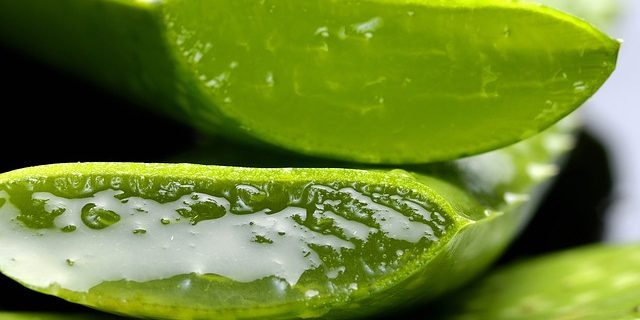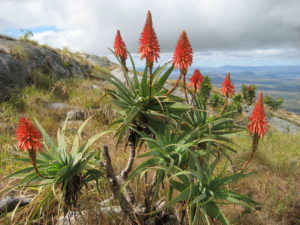Aloe is a great plant to have around. I was reminded of this the other night when I spilled some boiling water on my foot and found myself yowling in pain.
Fortunately the burn wasn’t serious, and fortunately I had some aloe leaves in the fridge that I had cut that day. After applying Lavender essential oil and rosewater to the burn, I cut a piece of aloe leaf and sliced it lengthwise, exposing the inner gel.
I fastened it to the burn with gauze, gel-side down. The pain vanished immediately, and by morning there was no sign of an injury. Thank you, Aloe!
Aloe’s reputation for soothing and healing skin injuries is age-old, and of course it’s wonderful for moisturizing and cleansing the skin even when there isn’t an injury. It rejuvenates dry skin and smooths out rough patches and wrinkles.
Aloe speeds the healing of wounds and reduces the likelihood of scarring. The gel has anti-microbial properties, so it’s great for wounds and skin conditions such as ulcers, fungal/bacterial infections, psoriasis, acne, dermatitis, and poison ivy/oak. The gel can be obtained by slicing a leaf lengthwise, exposing the inner gel, and scraping gently with a spoon.
What about Aloe’s internal uses?
Just as Aloe cools, heals, and protects burned and broken skin, it does the same for our intestinal mucosa. Aloe gel taken internally is a traditional remedy for inflammatory conditions of the gut of all kinds, including ulcers, colitis, gastritis, and acid reflux. A customer at the shop recently shared her favorite recipe for soothing ulcerative colitis flare-ups: fresh Aloe gel mixed with coconut water.
Nourishing the gut means nourishing the immune system, which makes Aloe an immune enhancer to a high degree. Aloe gel is incredibly nutritious, containing over 75 medicinally active compounds and numerous vitamins, minerals, and amino acids. It is used to flush out intestinal parasites such as pinworms, and it is a general detoxifier, helping release toxins from the system. Aloe’s immune-enhancing power also stems from its anti-microbial and anti-viral properties, inhibiting infections by bacteria, viruses, and fungi.
Aloe can also be used as a laxative in cases of bowel obstruction and constipation. When you slice the leaves to scrape out the gel, scrape deeply all the way to the rind. The yellow substance that resides close to the rind is what produces the laxative effect. If you’d like to avoid the laxative effect, scrape gently and collect only the clear gel.
Aloe asks very little of us as a houseplant. It likes a lot of sunshine and needs water only about once a month, or whenever the soil becomes completely dry. Next time you’re feeling the burn after a spicy meal, or you spill boiling water on your foot like me (I hope not), you’ll be glad your friend Aloe has got your back.
Internal use of Aloe gel should be avoided by pregnant and nursing mothers, due to its laxative effect.









